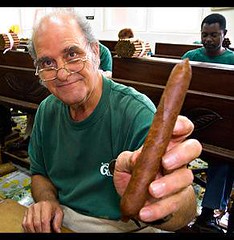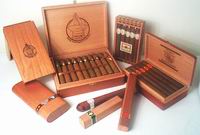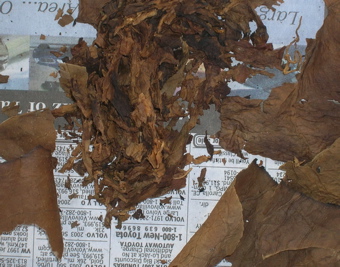Stogie Commentary: Gold Star Smokes
14 Jun 2007
Cigars can appeal for any number of reasons. Some offer a terrific bargain, others the opportunity to savor a rare treat. One cigar might earn a top rank because it can be enjoyed day after day, while another stick might be the perfect complement to a great Scotch. Whatever the appeal, we all have cigars that we think are special.
 We’ve decided to recommend some cigars we feel are particularly worthy of your attention and call them Gold Star Smokes. From time to time, we’ll clue you into three favorites – one from each member of the StogieGuys.com team. I guess you could consider anything posted here worthy of the Stogie Guys Hall of Fame, if such a thing existed.
We’ve decided to recommend some cigars we feel are particularly worthy of your attention and call them Gold Star Smokes. From time to time, we’ll clue you into three favorites – one from each member of the StogieGuys.com team. I guess you could consider anything posted here worthy of the Stogie Guys Hall of Fame, if such a thing existed.
Also, feel free to leave your own suggestions as comments, and we’ll consider adding them to future Gold Star Smokes posts.
Co-Founder & Editor in Chief Patrick A
My first choice for our Gold Star Smokes series was an instant classic the moment I took the inaugural puff. At six and ¼ inches with a 52 ring gauge, the Rocky Patel Vintage 1992 Torpedo is a well-aged Ecuadorian masterpiece with rich notes of dark roasted coffee beans and almond. It’s not cheap at $8.75, but clearly worth every penny. This has become my one go-to cigar for extra-special occasions.
Co-Founder & Publisher Patrick S
The El Rey Del Mundo Robisto Larga is a favorite of mine that I seem to rediscover every six months. Big (six inches with a 54 ring gauge) and packed full of rich earth and chocolate flavors, it is the best vitola from the El Rey Del Mundo brand that never seems to get a fair shake. The presentation – each Robusto Larga is wrapped in tissue paper – makes it seem like a present, and the obscuro wrapper underneath is a pleasure to look at too. This is truly a rare cigar that goes equally well on the golf course or after a fancy dinner. All this for the bargain price of about three dollars per stick.
Tampa Bureau Chief George E
The Punch Champion is a little four and ½ inch bowling pin of a cigar that’s just plain fun to smoke. Pick one up and I’ll bet it feels great. Enjoy the light aroma of cedar before you light it. Best of all, it’s got that Punch spice, but it doesn’t stop there; other flavors kick in along the way. You can usually find them for around $4 per stick.

 Call me crazy, but sometimes when I sit down with one of these excellent cigars, I think about all the entrepreneurs, farmers, rollers, truck drivers, graphic designers, ink manufacturers, marketing professionals, and administrative support that went into transforming my stogie from idea to seed to leaf to finished product.
Call me crazy, but sometimes when I sit down with one of these excellent cigars, I think about all the entrepreneurs, farmers, rollers, truck drivers, graphic designers, ink manufacturers, marketing professionals, and administrative support that went into transforming my stogie from idea to seed to leaf to finished product.
 I imagine most of you are familiar with a number of boutique cigar makers, such as Bucanero and Pepin Garcia’s El Rey de los Habanos. But if you’re like me, there are many small operations whose names and cigars come as a complete surprise.
I imagine most of you are familiar with a number of boutique cigar makers, such as Bucanero and Pepin Garcia’s El Rey de los Habanos. But if you’re like me, there are many small operations whose names and cigars come as a complete surprise. Now don’t get me wrong. No one’s going to mistake a Cuban Reject for a Cuban puro, unless they’ve been smoking something mind-altering beforehand. But you aren’t going to get sick either. OK, I realize that’s not exactly a ringing endorsement, but don’t forget we’re talking about a stogie that you can get for just a shade over a buck.
Now don’t get me wrong. No one’s going to mistake a Cuban Reject for a Cuban puro, unless they’ve been smoking something mind-altering beforehand. But you aren’t going to get sick either. OK, I realize that’s not exactly a ringing endorsement, but don’t forget we’re talking about a stogie that you can get for just a shade over a buck. Unlike many of the ultra low-cost cigars – which wouldn’t be seen, much less stocked, in most cigar shops – Alcazars are relatively easy to find. Perhaps that’s due to their connection to the storied Fuente line. As noted on the company’s website, the “Nicaraguan Alcazar bundle†brand is produced by “partners†of the J.C. Newman Cigar Co.
Unlike many of the ultra low-cost cigars – which wouldn’t be seen, much less stocked, in most cigar shops – Alcazars are relatively easy to find. Perhaps that’s due to their connection to the storied Fuente line. As noted on the company’s website, the “Nicaraguan Alcazar bundle†brand is produced by “partners†of the J.C. Newman Cigar Co. Patrick Ashby
Co-Founder & Editor in Chief
Patrick Ashby
Co-Founder & Editor in Chief Patrick Semmens
Co-Founder & Publisher
Patrick Semmens
Co-Founder & Publisher George Edmonson
Tampa Bureau Chief
George Edmonson
Tampa Bureau Chief